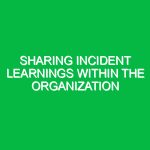Learning from safety incidents is a crucial aspect of the Health, Safety, and Environment (HSE) domain. It involves examining past events to identify what went wrong, understanding how similar incidents can be prevented in the future, and fostering a culture of safety that prioritizes the well-being of employees and the environment. This process is not merely about compliance; it’s about improving practices, reducing risks, and ultimately saving lives. With the right approach, organizations can turn incidents into valuable lessons that enhance their safety protocols and performance.
The Relevance of Learning from Safety Incidents
In many industries, safety incidents are often viewed as unfortunate but unavoidable events. However, the reality is that every incident tells a story. By diving into these stories, organizations can extract insights that might not only prevent recurrence but also bolster their safety culture. For instance, when a construction worker was injured due to a fall from height, a thorough investigation revealed that inadequate training and poor equipment maintenance were significant contributors. This tragic incident prompted a complete overhaul of safety training and equipment protocols at the site, which ultimately resulted in a safer working environment.
Moreover, learning from safety incidents helps organizations comply with legal and regulatory standards. The consequences of neglecting safety can be severe, ranging from financial penalties to reputational damage. Hence, integrating lessons learned into safety practices not only safeguards employees but also protects the organization’s interests.
Identifying Hazards and Risks
Understanding the potential hazards and risks associated with safety incidents is foundational to effective learning. Hazards can be broadly categorized into several types, including physical, chemical, biological, ergonomic, and psychosocial. Each category presents unique risks that can lead to incidents if not appropriately managed.
Physical Hazards
Physical hazards are perhaps the most visible. These include machinery, falling objects, and slips, trips, and falls. For instance, consider a manufacturing plant where workers often operate heavy machinery. If safety guards are not installed or maintained, the risk of injury increases significantly. In a case study from an industrial facility, a worker’s hand was injured because a safety guard was removed for maintenance and not replaced. This incident led to a comprehensive review of maintenance procedures and a renewed emphasis on the importance of safety guards.
Chemical Hazards
Chemical hazards involve exposure to harmful substances, such as toxic materials, flammable liquids, or corrosive agents. A notable example is the case of a chemical plant explosion that occurred due to improper storage of flammable materials. The investigation revealed that safety data sheets were not adequately followed. As a result, the organization implemented stringent storage protocols and regular training on handling chemicals, significantly reducing the risk of future incidents.
Biological Hazards
Biological hazards include exposure to viruses, bacteria, and other pathogens. In healthcare settings, for example, the spread of infections can be a critical concern. A healthcare facility experienced a outbreak of healthcare-associated infections due to poor sterilization practices. After this incident, the facility adopted stricter sterilization protocols and launched a training program focused on infection control, illustrating the importance of learning from such incidents.
Ergonomic Hazards
Ergonomic hazards relate to the design of workspaces and the physical demands placed on workers. For instance, a logistics company found that employees were suffering from repetitive strain injuries due to improper workstation setups. By assessing and redesigning workspaces, the company not only improved employee comfort but also reduced the number of injuries, highlighting the benefits of learning from past incidents.
Psychosocial Hazards
Psychosocial hazards encompass stress, bullying, and other workplace tensions. The impact of such hazards can be profound, often leading to decreased productivity and increased absenteeism. A well-documented case involved an organization where employee burnout led to high turnover rates. Following an investigation, management instituted regular check-ins and mental health resources, demonstrating that learning from psychosocial incidents is equally essential for overall workplace safety.
Best Practices and Safety Precautions
To effectively learn from safety incidents, organizations must adopt a series of best practices and safety precautions. These actionable strategies can foster a culture of safety and prevent the recurrence of similar incidents.
Conduct Thorough Investigations
Every safety incident should trigger a detailed investigation. This process involves gathering facts, interviewing witnesses, and analyzing data to understand the root causes. It’s crucial to approach investigations without assigning blame, focusing instead on learning and improvement. For example, after a near-miss incident in a warehouse, a team conducted a root cause analysis that revealed lapses in communication regarding safety protocols. This led to the implementation of a new communication strategy that significantly improved safety awareness among employees.
Implement Regular Training Programs
Training is vital in ensuring that employees are aware of risks and understand how to mitigate them. Regular safety training sessions can reinforce the importance of safety protocols and keep employees updated on new practices. For instance, a utility company that faced several incidents related to working at heights introduced a comprehensive training program focused on fall protection. This initiative resulted in a marked decrease in fall-related incidents over the following year.
Encourage Open Communication
Fostering an environment where employees feel comfortable reporting near misses and unsafe conditions is vital. Organizations should encourage open dialogue about safety without fear of retaliation. An interesting example is a tech company that implemented a “safety suggestion box” allowing anonymous reporting of safety concerns. This initiative led to numerous valuable insights and improvements in workplace safety.
Regularly Review Safety Protocols
Safety protocols should not be static. Organizations need to review and update them regularly, especially after incidents. This practice ensures that safety measures evolve alongside changes in the workplace environment and employee responsibilities. A construction company that frequently reviewed its safety protocols after accidents significantly reduced its incident rate by adapting to the specific challenges of each project.
Incorporate Technology
Technology can play a pivotal role in enhancing workplace safety. From wearable safety devices that monitor environmental conditions to software that tracks safety training completion, leveraging technology can lead to better safety outcomes. For example, a logistics firm utilized drones to inspect hard-to-reach areas, which not only improved safety in inspections but also allowed for timely maintenance interventions.
Regulations and Standards Governing Learning from Safety Incidents
Several regulations and standards guide organizations in learning from safety incidents. Compliance with these regulations is not just about avoiding penalties; it’s about committing to best practices in safety management.
Occupational Safety and Health Administration (OSHA)
In the United States, OSHA sets forth regulations that require employers to provide a workplace free from recognized hazards. The General Duty Clause mandates that employers must learn from incidents and implement changes to prevent future occurrences. This regulation emphasizes the importance of proactive safety management and the need for continuous improvement.
International Organization for Standardization (ISO) 45001
ISO 45001 is an international standard that focuses on occupational health and safety management systems. It encourages organizations to identify and manage risks effectively, emphasizing the need to learn from past incidents to improve safety performance. Companies certified under ISO 45001 are often seen as leaders in safety management, demonstrating their commitment to learning and improvement.
National Institute for Occupational Safety and Health (NIOSH)
NIOSH provides research and recommendations to prevent workplace injuries and illnesses. Their guidelines encourage organizations to implement evidence-based practices that stem from learning from safety incidents. This approach underscores the significance of data-driven decision-making in safety management.
Conclusion
Learning from safety incidents is not just a regulatory requirement; it is an essential component of fostering a culture of safety within organizations. By identifying hazards, implementing best practices, and adhering to regulations, companies can significantly reduce the likelihood of future incidents. Each incident is a potential learning opportunity, and by embracing this mindset, organizations can not only enhance their safety performance but also protect their most valuable asset—their people. Ultimately, the goal is to transform every safety incident into a stepping stone toward a safer and more resilient workplace.


